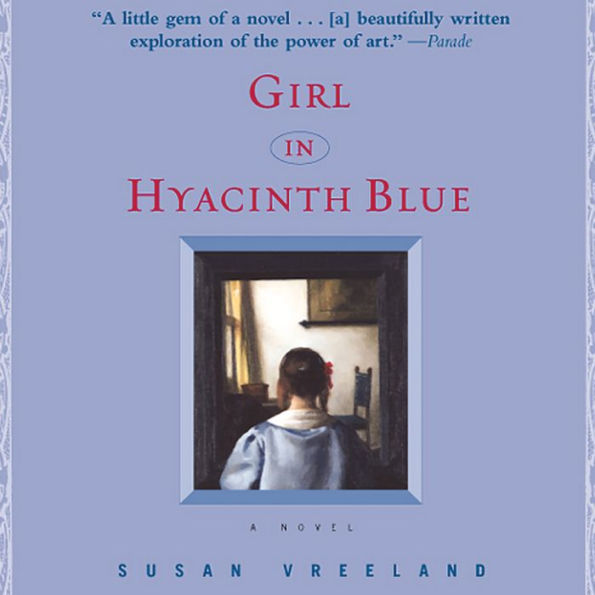A professor invites invites a colleague from the art department to his home to view a painting he has kept secret for decades, in Susan Vreeland's powerful historical novel, Girl in Hyacinth Blue. The professor swears it's a Vermeer -- but why exactly has he kept it hidden so long? The reasons unfold in a gripping sequence of stories that trace ownership of the work back to Amsterdam during World War II and still further to the moment of the painting's inception.
Picture this: "A most extraordinary painting in which a young girl wearing a short blue smock over a rust-colored skirt sat in profile at a table by an open window." Susan Vreeland imagined just such a humble domestic scene, suggested it was created in 17th-century Holland, and attributed it to Jan Vermeer. Then she wrote a beguiling novel about this canvas, which so closely resembles the 35 extant works of the Dutch master that it might as well be one of his--long, lost, finally found, and as exquisite as ever. The artistic journey Vreeland recounts begins in present-day Pennsylvania, where a schoolteacher claims he owns an authentic Vermeer, a legacy from his late father, who acquired it under heinous circumstances: a Nazi officer, the father had looted it from the home of Dutch Jews.
Moving back in time and across the Atlantic, Vreeland traces the treasured painting from owner to owner. In doing so, she demonstrates the enduring power of art in the face of natural disaster, political upheaval, and personal turmoil. Ultimately, she ends the odyssey in Delft, where the painting's haunting subject is identified and tells her own poignant story about the picture's origins.
Each of the eight linked chapters has an irresistible painterly quality--finely wrought, artfully illuminated, and subtly executed. Together, they constitute a literary masterpiece, one that the New York Times Book Review praised as "intelligent, searching, and unusual... filled with luminous moments; like the painting it describes so well."
1100360834
Moving back in time and across the Atlantic, Vreeland traces the treasured painting from owner to owner. In doing so, she demonstrates the enduring power of art in the face of natural disaster, political upheaval, and personal turmoil. Ultimately, she ends the odyssey in Delft, where the painting's haunting subject is identified and tells her own poignant story about the picture's origins.
Each of the eight linked chapters has an irresistible painterly quality--finely wrought, artfully illuminated, and subtly executed. Together, they constitute a literary masterpiece, one that the New York Times Book Review praised as "intelligent, searching, and unusual... filled with luminous moments; like the painting it describes so well."
Girl in Hyacinth Blue
Picture this: "A most extraordinary painting in which a young girl wearing a short blue smock over a rust-colored skirt sat in profile at a table by an open window." Susan Vreeland imagined just such a humble domestic scene, suggested it was created in 17th-century Holland, and attributed it to Jan Vermeer. Then she wrote a beguiling novel about this canvas, which so closely resembles the 35 extant works of the Dutch master that it might as well be one of his--long, lost, finally found, and as exquisite as ever. The artistic journey Vreeland recounts begins in present-day Pennsylvania, where a schoolteacher claims he owns an authentic Vermeer, a legacy from his late father, who acquired it under heinous circumstances: a Nazi officer, the father had looted it from the home of Dutch Jews.
Moving back in time and across the Atlantic, Vreeland traces the treasured painting from owner to owner. In doing so, she demonstrates the enduring power of art in the face of natural disaster, political upheaval, and personal turmoil. Ultimately, she ends the odyssey in Delft, where the painting's haunting subject is identified and tells her own poignant story about the picture's origins.
Each of the eight linked chapters has an irresistible painterly quality--finely wrought, artfully illuminated, and subtly executed. Together, they constitute a literary masterpiece, one that the New York Times Book Review praised as "intelligent, searching, and unusual... filled with luminous moments; like the painting it describes so well."
Moving back in time and across the Atlantic, Vreeland traces the treasured painting from owner to owner. In doing so, she demonstrates the enduring power of art in the face of natural disaster, political upheaval, and personal turmoil. Ultimately, she ends the odyssey in Delft, where the painting's haunting subject is identified and tells her own poignant story about the picture's origins.
Each of the eight linked chapters has an irresistible painterly quality--finely wrought, artfully illuminated, and subtly executed. Together, they constitute a literary masterpiece, one that the New York Times Book Review praised as "intelligent, searching, and unusual... filled with luminous moments; like the painting it describes so well."
18.87
In Stock
5
1
18.87
In Stock

Editorial Reviews
Product Details
| BN ID: | 2940171504441 |
|---|---|
| Publisher: | HighBridge Company |
| Publication date: | 09/18/2001 |
| Edition description: | Unabridged |
Videos

From the B&N Reads Blog

